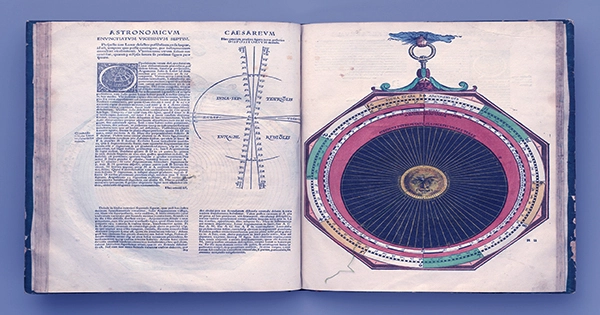Did you realize that smartphone apps had their origins in the Middle Ages? The volvelle, a paper-based interactive instrument, served many purposes throughout its history. It helped with celestial calculations, medical diagnostics, and navigation at sea.
Volvelles served as a timekeeper at night, allowing one to know when to administer medication, as well as a mathematical tool, as well as a visual aid for presenting complex theological concepts. Some have even compared Volvelles to an early analog computer.
Volvelles are multi-purpose paper wheel charts: Volvelles were typically made up of one or more revolving paper discs, or “wheels,” on which information or data was written or printed. Users would rotate these discs to align various pieces of information, allowing them to conduct computations or find answers to specific questions—hence the term “wheel chart.” Because they were composed of paper, they were also reasonably easy to construct (albeit they were initially limited to the elite due to the exorbitant cost of manufacturing parchment).

“Made from circles of paper or parchment, the volvelle was a part timepiece, part floppy disk, and part crystal ball,” the J. Paul Getty Trust stated. Volvelles were constructed of paper or parchment and had moving components that turned and pointed to celestial bodies on the timekeeper or qualities of God and proofs for His existence on the so-called “mystical volvelle.”
In reality, they resemble astrolabes, ancient metal instruments that predated volvelles and were used to see and calculate the positions of celestial planets. Volvelles are now being overtaken by the emergence of digital tools.
They do, however, appear on occasion in educational settings as intriguing curiosities, offering light on the historical foundations of calculating and visualization concepts.
Llull of Majorca and the World’s First Volvelles: Volvelles are thought to have been imported to Europe from the Arab East in the 11th and 12th century. Nonetheless, Ramon Llull of Majorca constructed the first existing instances of this type of interactive paper instrument. Llull was, in the words of Vice, “fascinated by an Arab device called a zairja, which was a mechanical divination device featuring rotating disks of letters that were meant to answer philosophical questions.”
Llull, regarded as one of Europe’s best philosopher-scientists of the 13th and 14th centuries, termed them volvelles, from the Latin word volvere, which means “to turn.”
According to a J. Paul Getty Museum article, Llull was a mystic philosopher. Llull was born in Majorca in 1232 and died there in 1315. According to History of Computers, he had a religious epiphany in 1265 and joined the Third Order of St. Francis of Assisi.
Llull taught the unification of the three Abrahamic faiths of Judaism, Christianity, and Islam. He also traveled to Tunis to convert Muslims to Christianity. He hoped that by combining the three religions, people of one faith would be able to battle the so-called “hordes of Asia” that were threatening and advancing on the Middle East and Europe.
He published alchemy, botany, astronomy, and other disciplines in addition to several religious treatises. He also wrote Blanquerna, the first Catalan novel, as well as the Ars Magna, which included Alia ars eleccionis, Ars eleccionis, and Ars notandi. Within these three volumes, Llull “anticipated by several centuries prominent work on elections theory.”
Calculating Time at Night with a Volvelle: According to the Getty Museum, the timekeeping, astrolabe-like volvelle worked as follows:
“At night, time was determined by aligning the device with a pole star; closing one eye; centering the cross of circles on the face, equidistant from both eyes; and locating another star rotating around the central star.” You might select your place in the universe if you don’t move your head or hands at all!”
The timepiece on display at the Getty is thought to be based on one of Llull’s volvelles known as “The Night Sphere.” This innovative arrangement allowed users to compute time at night, overcoming the lack of a sundial. Llull intended for it to be used to administer medicine at the most potent period, by celestial body movements.
Llull’s Mystical Volvelle and Religious Conflict Resolution: Believe it or not, Llull’s first volvelle was cleverly designed to aid in the resolution of religious disagreements. Llull attempted to represent the complete gamut of human intellect through an elaborate interplay of interwoven geometrical forms strictly adhering to a specific set of rules. “These declarations or statements were nevertheless represented only by a series of signs, that is chains of letters,” according to the History of Computers.
Some have claimed that Llull was a pioneer of computing theory and that his volvelle was the world’s first analog computer. “Lull’s radical innovation was the first physical tool ever used by logicians.” According to the National Catholic Register, “It allowed the user to combine seemingly disparate and incongruous aspects of thinking and language, which he connected by intricate geometrical figures.”
“The radical innovation Llull introduced in the realm of logic is, in fact, the construction and the use of a machine made of paper to combine elements of thinking, i.e. elements of language,” according to the History of Computers.
The letters in the mystical volvelle, a portion of which is displayed below, represent God’s nine attributes: B=Bonitas, C=Magnitudo, D=Duratio, E=Potestas, F=Sapientia, G=Voluntas, H=Virtus, I=Veritas, and K=Gloria. These words can be used in a variety of ways and used in conjunction with the rest of the volvelle to form sentences that Llull believed held logical truths.
Medieval Suspicion of the Innovative Volvelle:
Surprisingly, volvelles were thought to have the ability to predict the future, while numbers had magical significance long into the 16th century. Volvelle users faced suspicions and allegations during the Middle Ages, as these gadgets were sometimes linked to nefarious deeds and dark magic. Volvelles, however, gained a new purpose in conserving and creating knowledge as the tides of scientific thought shifted, becoming as valuable tools in the pursuit for enlightenment.
















